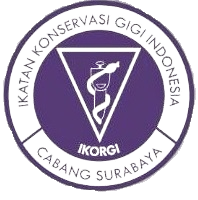Daya Hambat Aktivitas Enzim Glukosiltransferase (Gtf) Streptococcus mutans Oleh Ekstrak Temulawak (Curcuma Xanthorrhiza Roxb.)
Downloads
Background: Streptococcus mutans is a bacteria which has glucosyltransferase (GTF) enzyme and acts as the main agent that causes dental caries. GTF enzyme will convert sucrose into fructose and glucan. Temulawak (Curcuma xanthorrhiza Roxb.) is one of the traditional herbs which has xanthorrhizol, curcumin, flavonoid, tanin, and saponin as an antibacterial agent. Purpose: The purpose of this research is to investigate the effect of temulawak extract (Curcuma xanthorrhiza Roxb.) to the activity of GTF enzyme Streptococcus mutans. Method: This research used 25%, 37,5%, and 50% concentration of temulawak extract as the treatment, and 0.12% chlorhexidine gluconate as a control. The method of this research consists of three steps; preparing the temulawak extract concentration of 25%, 37,5%, and 50%, preparing the GTF enzyme from the supernatant of Streptococcus mutans, and testing GTF enzyme activity by analyzing the fructose concentration using High Performance Liquid Chromatography (HPLC). Perusal of the fructose area was based on the retention time of fructose. One unit of GTF enzyme activity is defined as the 1 μmol fructose / ml of enzyme / hour. Result: The obtained data then were analyzed by Post-Hoc Tukey (HSD). The result showed a significant difference between each treatment group with the control group (p<0.05). Conclussion: This research concludes that temulawak extract with 25%, 37,5%, and 50% concentrationcan't inhibit the GTF enzyme activity of Streptococcus mutans.
National Institute for Health Research & Development, 2013. Riset Kesehatan Dasar (National Health Survey). Ministry of Health Republic of Indonesia, (1).
Kidd EAM, Bechal SJ. 2012. Dasar-Dasar Karies-Penyakit dan Penanggulangan. Jakarta: Buku Kedokteran EGC.
Tulsani, S.G. et al., 2014. The effect of Propolis and Xylitol chewing gums on salivary Streptococcus mutans count: a clinical trial. Indian J Dent Res, 25(6), pp.737–741.
Zhu, F., Zhang, H. & Wu, H., 2015. Glycosyltransferase-mediated Sweet Modification in Oral Streptococci. Journal of Dental Research, 94(5), pp.659–665
Leistevuo, J. & Tenovuo, J., 2000. Resistance to mercury and antimicrobial agents in Streptococcus mutans isolates from human subjects in relation to exposure to dental amalgam fillings. Antimicrobial Agents and Chemotherapy, 44(2), pp.456–457.
Puspita, K.Y., 2014. Pengaruh Chlorhexidine Gluconate 0,12% Terhadap Keberhasilan Perawatan Periimplantitis Mucositis. Fakultas Kedokteran Gigi Universitas Mahasaraswati Denpasar.
Kankariya, A., Patel, A. & Kunte, S., 2016. The effect of different concentrations of water soluble azadirachtin (neem metabolite) on Streptococcus mutans compared with chlorhexidine. Journal of Indian Society of Pedodontics and Preventive Dentistry, 34(2), p.105.
Purnamasari,I. W., Astuti, P., Ermawati, T. Viabilitas neutrofil yang diinkubasi dalam ekstrak rimpang temulawak (Curcuma Xanthorrhiza Roxb) dan dipapar dengan Streptococcus mutans. Dentofasial. 2014; 13(3) :135-140.
Prasetianto, Dimas. 2015. Aktivitas Enzim Glukosiltransfersase (Gtf) Pada Streptococcus mutans Setelah Pemberian Probiotik Lactobacillus Reuteri. Karya Tulis Akhir Fakultas Kedokteran Gigi Universitas Airlangga
Putriyanti D. 1990. Identifikasi fruktosa pada beberapa jenis tappe serta pengamatan perubahan mikrobiologis dan biokimiawi tape singkong selama fermentasi [undergraduate thesis]. Bogor: Fakultas Teknologi Pertanian
Isnarianti, R., Wahyudi, I.A. & Puspita, R.M., 2013. Muntingia calabura L Leaves Extract Inhibits Glucosyltransferase Activity of Streptococcus mutans. Journal of Dentistry Indonesia, 20(3), pp.59–63.
Rukayadi, Y. & Hwang, J.K., 2006. In vitro activity of xanthorrhizol against Streptococcus mutans biofilms. Letters in Applied Microbiology, 42(4), pp.400–404.
Hegde, M.N., Patil, M., Shetty, S. 2012. An in vitro evaluation of antimicrobial activity of aqueous Curcuma longa ex- tract against endodontic pathogens. Int. J. Res. Phytochem. Pharmacol. ; 2(1): 1-6
Ferrazzano, Gianmaria et al. 2011. Plant Polyphenols and Their Anti-Cariogenic Properties: A Review. Molecules 16.12 (2011): 1486-1507
Umami, R.T., 2013. Pemanfaatan Rimpang Temulawak (Curcuma Xanthorrhiza Roxb) untuk Produksi Minyak Temulawak dengan Distilasi Vakum. Program Diploma Fakultas Teknik Universitas Diponegoro Semarang, pp.4–16.
Zahro, L., Agustini, R. 2013. Uji Efektivitas Antibakteri Ekstrak Kasar Saponin Jamur Tiram Putih (Pleurotus Ostreatus) Terhadap Staphylococcus Aureus Dan Escherichia Coli. Unesa Journal Of Chemistry. 2(3):120-129
Koo, H., Hayacibara, M. F., Schobel, B. D., Cury, J. A., Rosalen, P. L., Park, Y. K., Vacca-Smith, A. M., Bowen, W. H. Inhibition of Streptococcus mutans biofilm accumulation and polysaccharide production by apigenin and tt-farnesol. Journal of Antimicrobial Chemotherapy. 2003; 52: 782–789
Silva A.C.B., Stipp r.n., Graner, R.O.M., Sampaio, F.C., Araújo. D.A.M. Influence of Sub-Lethal and Lethal Concentrations of Chlorhexidine on Morphology andGlucosyltransferase Genes Expression in Streptococcus mutans UA159. Advances in Microbiology. 2014; 4: 945-954

CDJ by Unair is licensed under a Creative Commons Attribution 4.0 International License.
1. The journal allows the author to hold the copyright of the article without restrictions.
2. The journal allows the author(s) to retain publishing rights without restrictions










